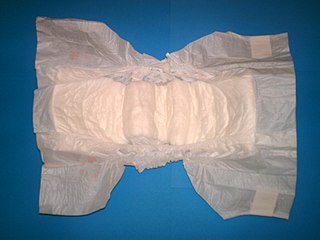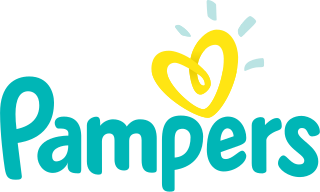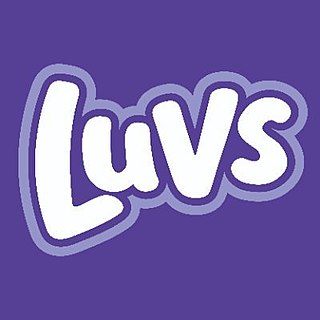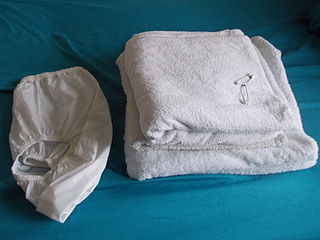
Toilet humour, or potty or scatological humour, is a type of off-colour humour dealing with defecation, diarrhea, constipation, urination and flatulence, and to a lesser extent vomiting and other bodily functions.

A diaper or a nappy is a type of underwear that allows the wearer to urinate or defecate without using a toilet, by absorbing or containing waste products to prevent soiling of outer clothing or the external environment. When diapers become wet or soiled, they require changing, generally by a second person such as a parent or caregiver. Failure to change a diaper on a sufficiently regular basis can result in skin problems around the area covered by the diaper.
Elimination communication (EC) is a practice in which a caregiver uses timing, signals, cues, and intuition to address an infant's need to eliminate waste. Caregivers try to recognize and respond to babies' bodily needs and enable them to urinate and defecate in an appropriate place. Caregivers may use diapers (nappies) as a back-up in case of "misses" some or all of the time, or not at all. EC emphasizes communication between the caregiver and child, helping them both become more attuned to the child's innate rhythms and control of urination and defecation. The term "elimination communication" was inspired by traditional practices of diaperless baby care in less industrialized countries and hunter-gatherer cultures. Some practitioners of EC begin soon after birth, the optimum window being zero to four months in terms of helping the baby get in tune with their elimination needs, although it can be started with babies of any age. The practice can be done full-time, part-time, or just occasionally.

Toilet training is the process of training someone, particularly a toddler or infant, to use the toilet for urination and defecation. Attitudes toward training in recent history have fluctuated substantially, and may vary across cultures and according to demographics. Many of the contemporary approaches to toilet training favor a behaviouralism- and cognitive psychology-based approach.

Pampers is an American brand of baby and toddler products marketed by Procter & Gamble.

Huggies is an American company that sells disposable diapers and baby wipes that is marketed by Kimberly-Clark. Huggies were first test marketed in 1968, then introduced to the public in 1977 to replace the Kimbies brand.

Plastic pants are garments worn over a diaper to prevent liquid or solid waste from leaking through the fabric. They are waterproof with a plastic texture, rather than a soft napkin texture. Plastic pants are usually made out of polyvinyl chloride (PVC) or polyurethane (PU).
Pull-Ups is a brand of disposable diapers made under the Huggies brand of baby products. The product was first introduced in 1989 and became popular with the slogan "I'm a big kid now!" The training pants are marketed with purple packaging: boys' designs are blue and currently feature characters from the Disney Junior show Mickey Mouse Funhouse; girls' designs are purple with the Disney Junior show Minnie's Bow-Toons characters.

Goodnites are diapers designed for managing bedwetting. Goodnites are produced by Kimberly-Clark. The product has also been seen titled as Huggies Goodnites on official Huggies branded webpages.

Luvs is a brand of disposable diapers made by Procter & Gamble. Luvs were sold as "Deluxe" diapers in the late 1980s. In 1994 they became budget diapers. The Luvs brand also includes baby wipes.

A cloth diaper or a cloth nappy, also known as reusable diaper or reusable nappy, is a diaper made from textiles such as natural fibers, human-made materials, or a combination of both. Cloth diapers are in contrast to disposable diapers, made from synthetic fibers and plastics. They are often made from industrial cotton which may be bleached white or left the fiber's natural color. Other natural fiber cloth materials include wool, bamboo, and unbleached hemp. Human-made materials such as an internal absorbent layer of microfiber toweling or an external waterproof layer of polyurethane laminate (PUL) may be used. Polyester fabrics microfleece or suedecloth are often used inside cloth diapers as a "stay-dry" wicking liner because of the non-absorbent properties of those synthetic fibers.
Omorashi, sometimes abbreviated as simply "omo", is a form of fetish subculture first categorized and predominately recognized in Japan, in which arousal from the idea or feeling of having a full bladder and potentially wetting themselves, or from witnessing another person in that situation.

An adult diaper is a diaper made to be worn by a person with a body larger than that of an infant or toddler. Adult Diapers can be necessary for adults with, or in, various conditions and circumstances, such as astronauts whose lives might be endangered if not wearing incontinence products while on space walks, and also while such astronauts are assigned to other similar tasks, poultry processing plant workers whose supervisors have been known to require the use of incontinence products, and there is even concern that Amazon drivers wear diapers, who are technically not allowed to enter most bathrooms while out on delivery.
gDiapers are a hybrid diaper, so users can choose to use either a cloth insert or a disposable insert that can be flushed or composted. Co-founders are Jason and Kimberley Graham-Nye. gDiapers began being sold in 2004. gDiapers are licensed from Kuver Designs Pty Ltd, Tasmania, "Eenee designs" diapers.

A swim diaper or swim nappy is a diaper that is made for those who have fecal incontinence, which is worn underneath a bathing suit, or as a bathing suit. Swim diapers can be reusable and disposable. They are not intended to be absorbent, but only to contain solid waste (feces); the lack of absorbency prevents the swim diaper from swelling with water.
Diaper fetishism, nappy fetishism, or diaperism is a type of garment fetish in which a person derives pleasure from wearing or using a diaper. Though separate and distinct, diaper fetishism can also be used as a component of various other kinks, such as ageplay or paraphilic infantilism, which together form a spectrum of practices colloquially referred to as "adult baby/diaper lover" or "AB/DL".

Open-crotch pants, also known as open-crotch trousers or split pants, are worn by toddlers throughout mainland China. Often made of thick fabric, they are designed with either an unsewn seam over the buttocks and crotch or a hole over the central buttocks. Both allow children to urinate and defecate without the pants being lowered. The child simply squats, or is held by the parent, eliminating the need for diapers. The sight of the partially exposed buttocks of kaidangku-clad children in public places frequently astonishes foreign visitors, who often photograph them. They have been described as being "as much a sign of China as Chairman Mao's portrait looming over Tiananmen Square."
A wetness indicator is a common feature in many disposable diapers and toilet training pants. It is a feature that reacts to exposure of liquid as a way to discourage the wearer to urinate in the training pants, or as an indicator a caregiver that a diaper needs changing.
Baby-led potty training is a system for meeting babies' toileting needs. The main feature of the system is that care-givers 'hold babies out' or support them on a potty in order for them to void in an appropriate place outside their nappy. The method is typically started before the baby is six months old. Care-givers use a combination of timing, and observing babies' own signals, to decide when to hold them out. In many countries it is the norm for parents to care for their babies without nappies from the first days of life. The term Baby-led potty training describes the method being used by a growing number of families in the UK. It is an adaptation of the techniques used in Africa, India and China amongst others, to fit into a modern Western life-style. It is similar to the US movement Elimination Communication, though UK proponents of the method emphasise its pragmatic approach with no strict rules, and it can be used by any type of parent. Some parents use the technique just occasionally, others as an alternative to full-time nappies, and some as a route to toilet independence.
Depend is a brand of absorbent, disposable underwear and undergarments for people with urinary or fecal incontinence. It is a Kimberly-Clark brand, and positions its products as an alternative to typical adult diapers. Depend is the dominant brand of disposable incontinence garments in the United States with a 49.4 share of the market.












